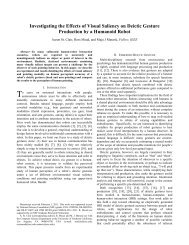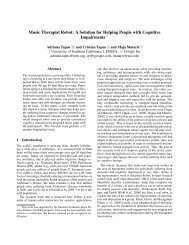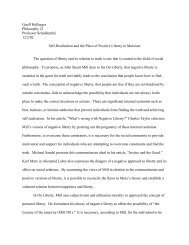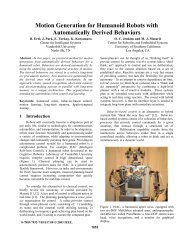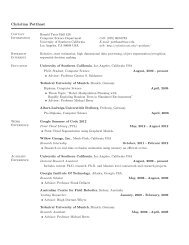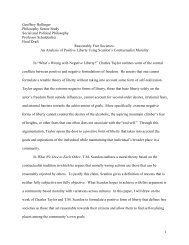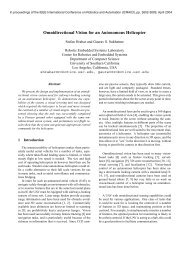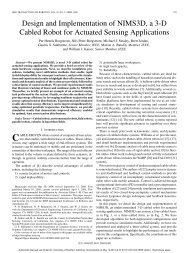A Socially Assistive Robot Exercise Coach for the Elderly
A Socially Assistive Robot Exercise Coach for the Elderly
A Socially Assistive Robot Exercise Coach for the Elderly
Create successful ePaper yourself
Turn your PDF publications into a flip-book with our unique Google optimized e-Paper software.
Fasola & Matarić. A SAR <strong>Exercise</strong> <strong>Coach</strong> <strong>for</strong> <strong>the</strong> <strong>Elderly</strong>providing direct feedback specific to <strong>the</strong> individual user’s per<strong>for</strong>mance level andper<strong>for</strong>mance history during <strong>the</strong> games, was an important part of personalizing <strong>the</strong>interaction. Our SAR exercise system introduced continuity (see Section 3.6) by having<strong>the</strong> robot refer to previous sessions with <strong>the</strong> user upon introduction, reference plannedfuture sessions at <strong>the</strong> end of interaction, and refer to past user exercise per<strong>for</strong>mance, suchas when reporting previous high scores.4) Intelligent. Trust is a key component to <strong>the</strong> success of any care-provider/userrelationship, and one that is closely linked to <strong>the</strong> intelligence/helpfulness of <strong>the</strong> careprovider as perceived by <strong>the</strong> user (Tway, 1994). Tway defines trust as a constructdetermined by three components: perception of competence, perception of intentions, andcapacity <strong>for</strong> trusting. In <strong>the</strong> context of SAR-based <strong>the</strong>rapy, <strong>the</strong> perceivedintelligence/competence of <strong>the</strong> SAR agent by <strong>the</strong> user is necessarily correlated with <strong>the</strong>agent’s demonstrated abilities in <strong>the</strong> <strong>the</strong>rapeutic task (e.g., per<strong>for</strong>mance capability,evaluation accuracy, etc.). In our SAR exercise scenario, <strong>the</strong> effectiveness of <strong>the</strong> robot’suser activity recognition procedure was paramount in shaping <strong>the</strong> user’s perception of <strong>the</strong>robot’s intelligence. (The algorithm is discussed in Section 3.5.) In particular, if <strong>the</strong> userwere to perceive <strong>the</strong> robot as slow or ineffective in evaluating per<strong>for</strong>mance, this couldlead to a decrease in <strong>the</strong> user’s trust and perception of <strong>the</strong> robot’s value/usefulness inhelping to accomplish <strong>the</strong> desired healthcare goals, according to Tway. This aspect onceagain stresses <strong>the</strong> importance of accurate, real-time sensing in <strong>the</strong> human-robotinteraction.Intelligent robot social behaviors can also have a positive impact on userengagement. For instance, it has been shown that repetitive discourse tends to have anegative impact on user motivation, whereas increased variability, in discourse andgeneral behaviors, tends to enhance task-based user engagement (Bickmore, Schulman,& Yin, 2010). There<strong>for</strong>e, in our SAR system, we placed special attention on ensuringvariety in <strong>the</strong> robot’s utterances to minimize <strong>the</strong> perceived repetitiveness of <strong>the</strong> robot’sverbal instructions/comments. Toward this end, <strong>the</strong> robot always draws from a list ofphrases that emphasize <strong>the</strong> same point when speaking to <strong>the</strong> user, choosing one randomlyat run time. For example, <strong>the</strong>re are more than ten different ways in which <strong>the</strong> robot canpraise <strong>the</strong> user after he or she completes an exercise (e.g., “Awesome!”; “Nice job!”;“Fantastic!”). Variability is also introduced in discourse during game transitions, gameintroductions, and upon farewell. General interaction behaviors were also designed toreduce predictability; <strong>for</strong> example, by ensuring that <strong>the</strong> order of games, game timing, andsession schedules were different <strong>for</strong> each interaction. Fur<strong>the</strong>r in<strong>for</strong>mation regarding <strong>the</strong>methods employed to add variability to our SAR behaviors and interaction sessions isprovided in Section 3.6.5) Task-Driven. Perhaps <strong>the</strong> most important property of <strong>the</strong> interaction is that it beconsistent in working to achieve <strong>the</strong> goals of <strong>the</strong> healthcare task, or in our case, inmotivating exercise per<strong>for</strong>mance to achieve desired overall health benefits. As mentionedabove, it is important <strong>for</strong> <strong>the</strong> task to be intrinsically motivating and enjoyable and <strong>for</strong> <strong>the</strong>coach be personable and intelligent. However, <strong>the</strong> consistency of <strong>the</strong> interaction towardsaccomplishing <strong>the</strong> healthcare task is fundamental <strong>for</strong> <strong>the</strong> user to trust that <strong>the</strong> system canhelp to obtain beneficial health outcomes, as this consistency influences <strong>the</strong> user’sperception of <strong>the</strong> intentions of <strong>the</strong> SAR agent. Agent intentions, according to Tway(1994), must be seen as mutually beneficial. Without this consistency, users may perceive<strong>the</strong> robot as simply entertaining, ra<strong>the</strong>r than helpful.7



